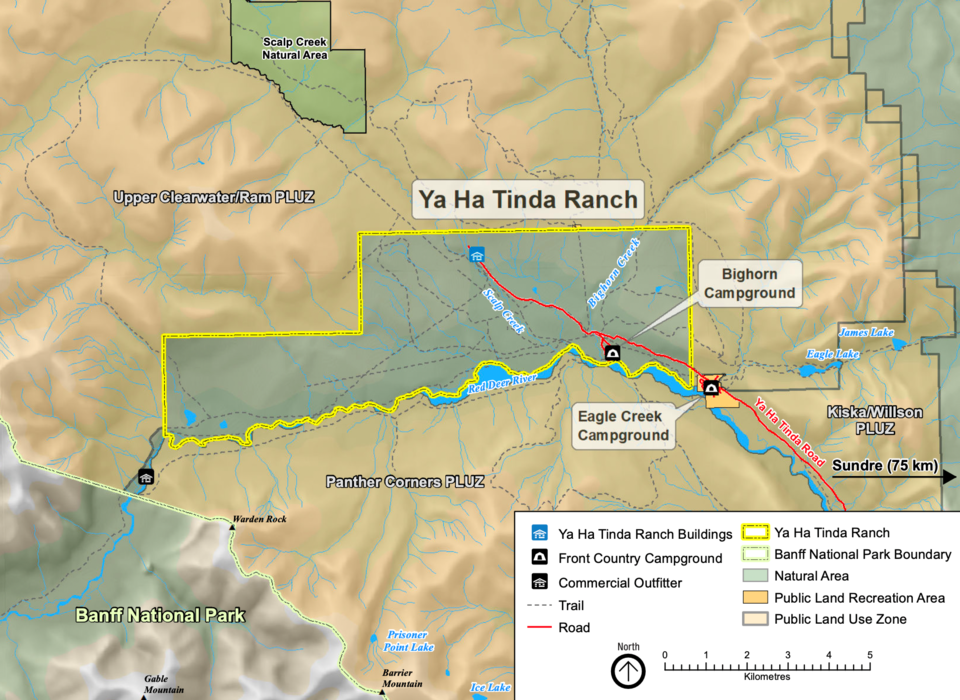BANFF – Ya Ha Tinda Ranch is a special place for many people, with rich connections past and present.
So much so that Parks Canada is working on an application to have Ya Ha Tinda Ranch – the federal agency’s only working ranch where horses are wintered and trained for patrolling Canada’s western national parks – recognized for its contribution to biodiversity conservation.
Located 1.5 kilometres outside of Banff National Park and running 27 km along the north bank of the Red Deer River, the 3,945-hectare ranch is currently not a designated protected area as it is currently operated and managed by Parks Canada.
However, there are strong indicators it meets criteria for Other Effective Area-Based Conservation Measures (OECM) – a new category that countries can report as contributing to the protection of biodiversity under the United Nations Convention on Biological Diversity.
Parks Canada officials say Ya Ha Tinda Ranch – which has been operated by the federal government for more than 100 years – lies within rare montane grasslands with an abundance of wildlife including grizzly bear, wolf, cougar, moose, deer, and bighorn sheep, and is a major winter range for about 1,000 elk.
“Ya Ha Tinda Ranch contains intact montane grasslands which is rare and underrepresented and provides habitat to a range of wildlife – most notably winter range for a herd of elk,” said Natalie Fay, external relations manager for Banff National Park in an email.
“Its watercourses are home to fish which are protected as species at risk. Many different bird species have been recorded on the property, including species of conservation concern. Ya Ha Tinda is also an important part of our cultural and social heritage.”
The history of Ya Ha Tinda area – which means “mountain prairie” in Îyârhe/Stoney – runs deep, with archaeological evidence indicating that the area has been used by Indigenous peoples for more than 9,400 years.
Many camps, tipi rings and artifacts have been found, while remains of pre-historic bison have been unearthed as well. In addition, the Red Deer River is thought to be a major trading route since more camps exist west along the river towards the Continental Divide.
According to Parks Canada’s website, the Brewster Brothers Transfer Company obtained a grazing lease in the area in the early 1900’s, and by 1908, they were raising and breaking horses there for their guiding and outfitting business.
The Ya Ha Tinda ranch area was formerly within the boundaries of Rocky Mountains National Park, and following a number of boundary changes, the national parks took over the area as a winter range, breeding and training facility for park horses in 1917.
Parks Canada officials say the designation of Ya Ha Tinda Ranch as an OECM would contribute to Canada’s commitment of protecting biodiversity and conserving 25 per cent of land and inland waters and 25 per cent of marine and coastal areas by 2025, working toward 30 per cent by 2030.
“Ya Ha Tinda Ranch could be the first recognized OECM in Alberta,” said Fay in her email.
Parks Canada officials say recognition of Ya Ha Tinda as an OECM will not result in any changes to existing activities, uses, or access, noting hunting will continue to be permitted, current access will be maintained, and operations as a working horse ranch will continue.
“The way the Ya Ha Tinda Ranch is currently operated will not change with OECM recognition, but if the application is successful, the site will be formally recognized for the positive contributions it makes towards conservation and Canada’s environmental goals,” said Banff National Park superintendent Sal Rasheed in his letter to stakeholders.
“Ya Ha Tinda Ranch is a special place with many current and historic connections and uses.”
Parks Canada is carrying out two phases of consultation on its intent to seek OECM recognition, the first of which began with Indigenous nations and targeted stakeholders in March and runs until May 13.
Phase two will involve a broader reach to include all Canadians, who will be invited to learn about and provide feedback on the OECM application, sometime this summer.
“Parks Canada is committed to meaningful engagement on this initiative to ensure the views and values of Indigenous nations, stakeholders and the public are reflected in the Ya Ha Tinda Ranch OECM application,” said Fay.




